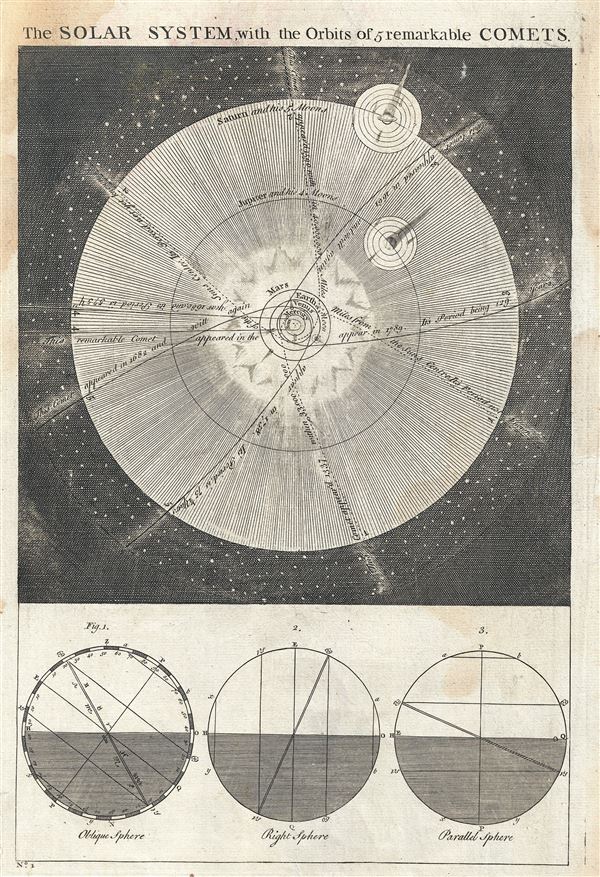This item has been sold, but you can get on the Waitlist to be notified if another example becomes available, or purchase a digital scan.
1747 Bowen Map of the Solar System showing 5 Comets
SolarSystemComets-bowen-1747
Title
1747 (undated) 13.5 x 9 in (34.29 x 22.86 cm)
Description
This chart was produced by Emanuel Bowen for issue as plate no. 1 in the 1747 first edition of his Complete System of Geography.
- 1337 - ????. Most likely the Perseid Comet. Bowen does not offer a return date, but if it is the Perseid Comet, it reappeared in 1468, with 131 year window. The speculative nature of this comet's path is indicated by a dotted line.
- 1590 - ????. Another speculative comet, but most likely an early observation of Halley's Comet, which appeared in 1590.
- 1661 - 1789, 129 years. In all probability Comet Ikeya-Zhang which reappeared in 2002. The 18th century calculations performed by Johannes Hevelius giving this comet a 129 year orbit were apparently incorrect. The Chinese and Japanese astronomers Zhang Daqing and Kaoru Ikeya, respectively, recalculated the course of the comet following its 2002 appearance giving it a 366.51 year orbit, the longest of any periodic comet.
- 1680 - Doubtless this is the Great Comet of 1680, also called Kirch's Coment or Newton's Comet. Visible even during the day with a spectacular tail that bisected the night sky, this was one of the brightest comets in recorded history. This sungrazing comet was discovered by Gottfried Kirch and Eusebio Kino (better known in map circles for proving California's peninsular nature). This comet was also used by Isaac Newtown to test Kepler's laws. As a non-periodic comet it is not known when or if this spectacular satellite will return.
- 1682 - 1758, 75 1/2 years. Halley's Comet, which appeared in 1759 and has a 75-76 year orbit.
Cartographer
Emanuel Bowen (1694 - May 8, 1767) had the high distinction to be named Royal Mapmaker to both to King George II of England and Louis XV of France. Bowen was born in Talley, Carmarthen, Wales, to a distinguished but not noble family. He apprenticed to Charles Price, Merchant Taylor, from 1709. He was admitted to the Merchant Taylors Livery Company on October 3, 1716, but had been active in London from about 1714. A early as 1726 he was noted as one of the leading London engravers. Bowen is highly regarded for producing some of the largest, most detailed, most accurate and most attractive maps of his era. He is known to have worked with most British cartographic figures of the period including Herman Moll and John Owen. Among his multiple apprentices, the most notable were Thomas Kitchin, Thomas Jeffreys, and John Lodge. Another apprentice, John Oakman (1748 - 1793) who had an affair with and eventually married, Bowen's daughter. Other Bowen apprentices include Thomas Buss, John Pryer, Samuel Lyne, his son Thomas Bowen, and William Fowler. Despite achieving peer respect, renown, and royal patronage, Bowen, like many cartographers, died in poverty. Upon Emanuel Bowen's death, his cartographic work was taken over by his son, Thomas Bowen (1733 - 1790) who also died in poverty. More by this mapmaker...

